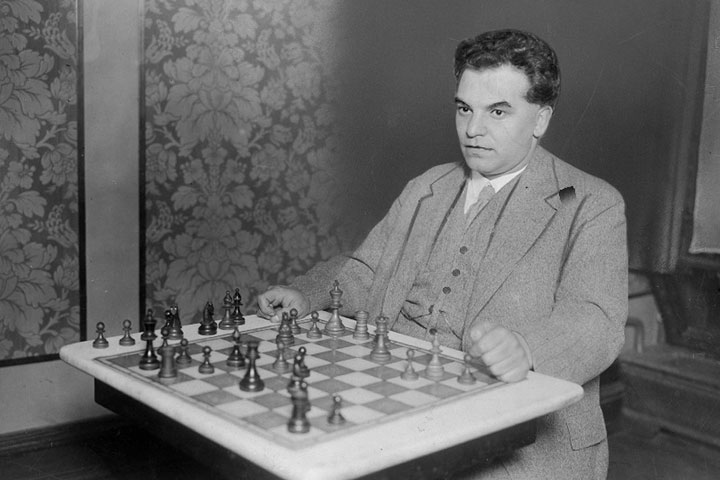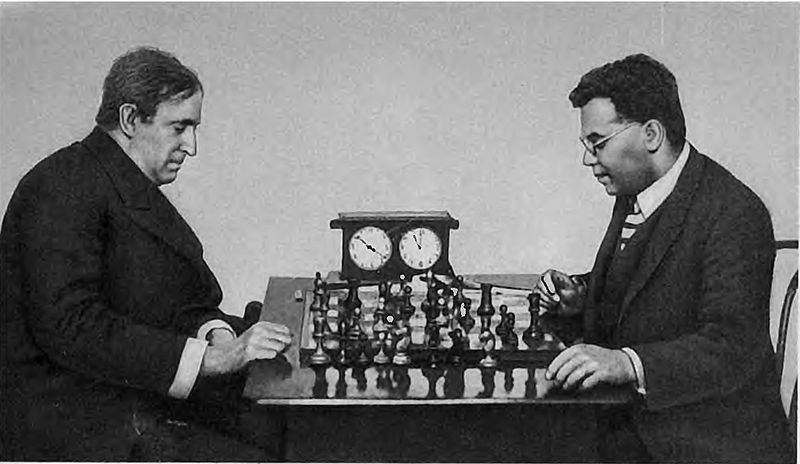


Réti’s successes in practical play were impressive, being one of the leading masters of the early 20th century. After coming last in the 1908 Vienna tournament, it took four more years for Réti to be recognized as brilliant player. Starting in 1920, Réti became a writer instead. Playing again in New York 1924, he won the Brilliancy Prize (EB). Perhaps “instead” is the wrong word as Réti had his greatest successes in the tournaments Kaschau (Kassa) in Hungary 1918 (where he won two points ahead Vidmar with 10/11, getting an invitation to reside in the Netherlands shortly after), Gothenburg 1920 (winning with 9½/14), Teplitz-Schönau 1922 (1st/2nd place with Spielmann, 9/14), Mährisch-Ostrau 1923 (2nd behind Lasker), Vienna 1923 (2nd behind Tartakower) and the Dr. Körner tournament by the sports club Aka Hakoah, in Vienna, 1928 (winning with 10½/13, two points ahead of Albert Becker, Bernhard Lichtenstein, Spielmann and Tartakower with shared 2nd/5thprize). I was unable to find a table for Rotterdam 1919 which Réti supposedly also won. In 2018 Réti was admitted into the World Chess Hall of Fame.
To give an example of the money prizes at the time, Réti received 600 ATS (Austrian Shilling) for his Vienna 1928 win (around USD $75 USD in 1928 dollars or a bit over $1,100 in purchasing power today), the other four players mentioned above each received 350 ATS.
While finishing the study selection for the first part, I found that Réti had a bad accident in July or August 1923 when he was forced to attend the accident ward in the General
Hospital in Vienna after suffering a fracture of the lower leg, as reported in the Neue Wiener Schach-Zeitung, 7/8 1923, p.289.

F. J. Marshall - R. Reti, Moscow 1925 chess tournament, 2nd round (11th November) | Photo: Unknown [Public Domain via Wikimedia Commons]
Artur Mandler (also Czechoslovakia, 1891-1971, see my March column) slightly edited and published the Sämtliche Studien von Richard Réti in 1931, containing 53 of his endgame studies prepared by Réti himself. According to another source I have, a 1917 Selezniev study was later published with Réti’s name as well, so because of the predecessor it is not included in the book. Sadly my source gives no publication details for Réti’s version other than the position. The book by Réti and Mandler is available online in German and Russian (as Mandler died in 1971 and thus the copyright still is in effect, we can’t link it here). Réti’s career as chess composer was rather short, spanning only from 1921 until his death. From what I can see, there are 116 studies in the database of Harold van der Heijden, including twins, corrections and versions, where around 60 of them are unique (if twins count as single study). Eleven studies were awarded, five of them with prizes. His world-famous study that won the Shakhmaty informal tourney for the first half of 1928 is the fourth entry in the game viewer below, was in part 1 of this article.
Réti’s collection was prepared by himself as his legacy during his northern tour in 1929. As Mandler writes, Réti’s careful but hasty work during those three weeks was not too early, as Réti’s unexpected death just weeks later proved. The studies not added to the book were “orphaned” by Réti to be regarded as non-existant. Respecting the wish of the master, only studies included in his book were found in the selection on the first part of this article, marked by “S. S.” for “Sämtliche Studien” and their number in the book. You can find the solution for the last study presented in part 1 in the selection below. (Unfortunately when splitting the article into two parts, I forgot to correctly mention this in the first part, leaving possibly readers to wonder why no solution was given yet.)
The aesthetic point of Réti’s thinking is laid out on four pages in Mandler’s book, which is our source for the following text. For Réti, a study was an endgame with extraordinary content (or more precisely, as Mandler writes, an endgame where only one method — but not necessarily only one move — leads to the objective, as evidenced by Réti’s famous study where 1.♖d2 or ♖d3 and 2.♖d1 wins, but not 1.♖d1 immediately due to zugzwang).
Réti had views seen as controversial by study composers in our time, namely that having the other side (i.e. Black) to move first in a study does not diminish its value (the common current view is that it is fine if Black moves first, but there should be a reason for it), and that it is not necessary to stipulate if White should win or draw (in my opinion, this would be justified if used in chess training — one could show a position to the pupils and ask what the best outcome is. Apart from that, most composers however will always want the stipulation to be shown, otherwise they will stipulate something akin to “Can White win?”). Réti believed that an endgame study must have outstanding content discerning it from usual endgames. As the majority of published endgame studies in his time was not extraordinary, compared to “normal” endgames, Réti likely would have debated their value. With this view, Réti acknowledged however that some endings found in practical games also have a high value as endgame study.[1]
Réti usually made no distinction in his terminology between a practical endgame and an endgame study, as he saw practical endgames also as endgame studies if they contained the extraordinary content outlined below. As such, Réti found that the blind appliance of rules for chess problems (i.e. checkmates in a specific number of moves) to endgame studies was rather damaging them.
There were several things that could make an endgame study special for Réti, such as the difficulty, purity of aim, rich content, originality, orderliness, echo variations, etc. Obviously not all studies can have all of those attributes, and they shouldn’t be enforced on the studies. As such, the first study in the book (the second entry on our game viewer below) shone by originality (in modern terminology it also would have paradoxical and geometrical content), but not by for example its difficulty. Although the position looks lost for White at first sight, the counterexample, a study that looks easily drawn or won at first sight, does not lose value by having an easy solution. In one case, a judge dismissed studies by various authors because their initial position already looked as if the stipulation is easily reached, causing Réti’s protest.
Réti usually highly valued the simplicity and economy of a position, sought purity of aim and enjoyed interesting and difficult tries, even if the endgame study became so difficult that it would become impossible for most people to completely understand it. Pure checkmates and stalemates as well as echo variations were favourites of Réti, but he avoided echo variations if those would have obscured the main idea. As he composed problems prior to studies, the mate pictures coming naturally and economically were seen as a great advantage while rather enforced (not in gameplay but composing terms) mate picture studies could be devalued by the disadvantages of such studies. Furthermore, even a good checkmate could be disadvantageous if it diluted the main idea of a study. Similar thinking applied to stalemates. So great play leading to an impure checkmate position would be higher in value to Réti than dull play leading to a beautiful checkmate. As such, the stalemates in Réti’s studies, while being in accordance with aesthetic values themselves, were accompanied by natural play.
Réti classified two composition methods: One could investigate rather simple positions, giving an artistic form to worthwhile endgames, or — his less preferred method — one would start with a point or checkmate/stalemate picture, working “backwards” to add play to it.[2]
Réti’s favourite study composer, according to Mandler’s account in the book, was Hermanis Matisonis (also known in the Germanized form Hermann Mattison).
If you look for the endgame studies of Richard Réti, you can see the first part of this article or the two-part Benkö article linked there. A selection of four replayable games, three of them short attacking games, is below. This is by no means a representative collection of Réti’s best games, but rather shows some in my opinion interesting battles and ideas. If you want, you can of course share Réti games you love for other readers to see in the comments.
Click or tap an entry in the list to switch positions
You probably know that you can move pieces on our replay boards to analyse and even start an engine to help you. You can maximize the replayer, auto-play, flip the board and even change the piece style in the bar below the board.
At the bottom of the notation window on the right there are buttons for editing (delete, promote, cut lines, unannotate, undo, redo) save, play out the position against Fritz and even embed the ChessBase game viewer on your website or blog. Hovering the mouse over any button will show you its function.

World Federation for Chess Composition (www.wfcc.ch)
[1] I believe that the recently (not) played ending of game 6 of the World Chess Championship would have fallen into that category. When preparing an article, I thought I remembered seeing such a manoeuvre in an endgame study but was unable to find that study.
[2] I used to use the first method but later switched to the second — a matter of preference, it seems. While this lowered his output, it raised the value of his studies. In many cases, Martin Minski’s capability of adding natural or interesting play prior to such a point creates a symbiotic mutually beneficial co-authorship.